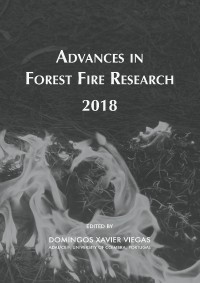Please use this identifier to cite or link to this item:
https://hdl.handle.net/10316.2/44663| DC Field | Value | Language |
|---|---|---|
| dc.contributor.author | Pérez-Ramirez, Y. | |
| dc.contributor.author | Filippi;, J B | |
| dc.contributor.author | Ferrat, L | |
| dc.date.accessioned | 2018-11-11T10:19:01Z | |
| dc.date.accessioned | 2020-09-06T17:30:52Z | - |
| dc.date.available | 2018-11-11T10:19:01Z | |
| dc.date.available | 2020-09-06T17:30:52Z | - |
| dc.date.issued | 2018 | - |
| dc.identifier.isbn | 978-989-26-16-506 (PDF) | |
| dc.identifier.uri | https://hdl.handle.net/10316.2/44663 | - |
| dc.description.abstract | The goal of the FireCaster project is to develop a new generation national (French) scale Wildfire Decision Support System (FCDSS) to provide operational agencies more efficient ways to forecast fire danger and handle ongoing crisis. A key task of the project concerns fuel, defined as dead and live biomass. On the one hand, fuel characteristics are required inputs for fire behavior models, which are used in the framework of the project to predict the fire front evolution and to compute probabilistic risk by means of mass ensemble simulations. On the other hand, one of the objectives of the project is developing the methods and procedures to predict fuel state (e.g. live and dead fuel moisture content, fuel loading) and its spatiotemporal evolution across the landscape from an operational land surface model. To respond to these needs it is primary necessary to determine which fuel variables are needed and at which scale and level of detail, and to conceive the data structure to store the geo-referenced fuel variables. Fuel description systems have been traditionally developed to match input variables of a particular fire behavior model. However, advances in computing capabilities and simulations techniques have opened up new possibilities for modelling fire behavior and fuels at finer scales. FCDSS has been designed with genericity and evolvability in mind, in order to match a variety of uses and sources of fuel data. In order to tackle these challenges, the FireCaster Fuel Descriptions System (FCFDS) has been defined based on the review of existing fuel classification and descriptions systems, fuel input parameters of the current fire behavior models and the goals of the FireCaster project. In the FCFDS a vegetation stand is composed by one or more structurally distinct pseudo-homogeneous geo-referenced fuel layers, which in turn are composed by fuel elements (i.e. individual plant of a stand, e.g. tree, shrub) or fuel particle arrangements (e.g. herb patch) sharing the same structural, physical, chemical and physiological response characteristics. Fuel elements are in turn composed by different sizes and types of fuel particles (i.e. leaves, twigs, branches). A set of fuel layer attributes has been defined to describe the state, structure and arrangement of fuel. Fuel layer attributes related to fuel state will be predicted by using the operational land surface model SURFEX, which takes into account the soil-vegetation-atmosphere interactions. Correspondingly, a set of fuel elements and fuel particles attributes has been defined. These attributes can be shared by elements and particles in fuel layers located at different positions in the landscape. The way fuel data is structured in FCFDS allows to consider different levels of detail, from the stand scale to the particle scale. Moreover, linkages to different fire behavior models will be developed by means of adaptors. This paper introduces the framework for the definition of the FCFDS, as well as the structure, the associated fuel attributes and the range of spatial scales considered. Moreover, an example of application will be presented. | eng |
| dc.language.iso | eng | - |
| dc.publisher | Imprensa da Universidade de Coimbra | por |
| dc.relation.ispartof | http://hdl.handle.net/10316.2/44517 | por |
| dc.rights | open access | - |
| dc.subject | Fuel modelling | eng |
| dc.subject | Fuel attributes | eng |
| dc.subject | Fuel Description System | eng |
| dc.subject | Wildfires | eng |
| dc.title | FireCaster Decision Support System: on the need for a new fuel description approach | por |
| dc.type | bookPart | por |
| uc.publication.firstPage | 1233 | - |
| uc.publication.lastPage | 1235 | - |
| uc.publication.location | Coimbra | por |
| dc.identifier.doi | 10.14195/978-989-26-16-506_146 | - |
| uc.publication.section | Chapter 7 - Short Contributions | por |
| uc.publication.digCollection | PB | por |
| uc.publication.orderno | 146 | - |
| uc.publication.area | Ciências da Engenharia e Tecnologias | por |
| uc.publication.bookTitle | Advances in forest fire research 2018 | - |
| uc.publication.manifest | https://dl.uc.pt/json/iiif/10316.2/44663/203795/manifest?manifest=/json/iiif/10316.2/44663/203795/manifest | - |
| uc.publication.thumbnail | https://dl.uc.pt/retrieve/11055865 | - |
| uc.publication.parentItemId | 55072 | - |
| uc.itemId | 68743 | - |
| item.fulltext | With Fulltext | - |
| item.grantfulltext | open | - |
| Appears in Collections: | Advances in forest fire research 2018 | |
Files in This Item:
| File | Description | Size | Format | |
|---|---|---|---|---|
| firecaster_decision_support_system.pdf | 701.59 kB | Adobe PDF |  |
Items in DSpace are protected by copyright, with all rights reserved, unless otherwise indicated.
